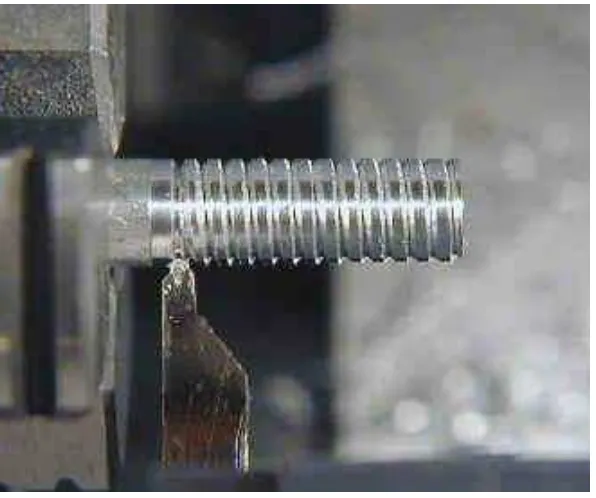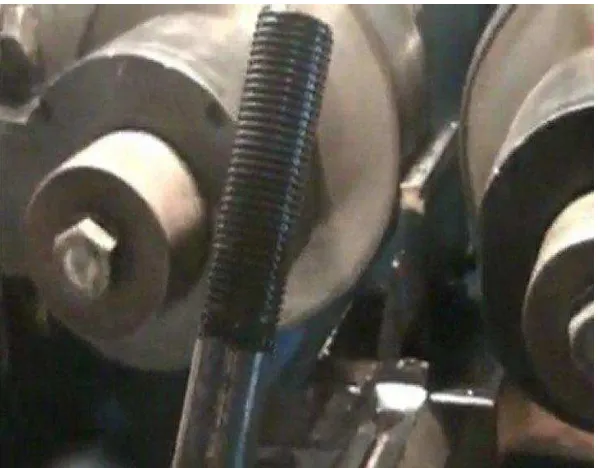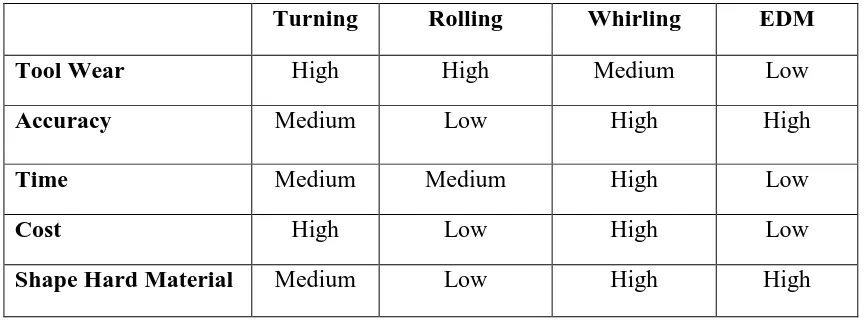NOVEL EDM SCREW THREADING TECHNIQUE USING
THREADED CAVITY ELECTRODE
AHMAD HISYAMUDDIIN BIN HASSAN
B050910008
UNIVERSITI TEKNIKAL MALAYSIA MELAKA
NOVEL EDM SCREW THREADING TECHNIQUE USING
THREADED CAVITY ELECTRODE
This report submitted in accordance with the requirement of the UniversitiTeknikal Malaysia Melaka (UTeM) for the Bachelor Degree of Manufacturing Engineering
(Manufacturing Process) (Hons.)
by
AHMAD HISYAMUDDIIN BIN HASSAN
B050910008
871015-26-5145
UNIVERSITI TEKNIKAL MALAYSIA MELAKA
BORANG PENGESAHAN STATUS LAPORAN PROJEK SARJANA MUDA
TAJUK: Novel EDM Screw Threading Technique using Threaded Cavity ELectrode
SESI PENGAJIAN: 2012/13 Semester 2
Saya AHMAD HISYAMUDDIIN BIN HASSAN
mengaku membenarkan Laporan PSM ini disimpan di Perpustakaan Universiti Teknikal Malaysia Melaka (UTeM) dengan syarat-syarat kegunaan seperti berikut:
1. Laporan PSM adalah hak milik Universiti Teknikal Malaysia Melaka dan penulis. 2. Perpustakaan Universiti Teknikal Malaysia Melaka dibenarkan membuat salinan
untuk tujuan pengajian sahaja dengan izin penulis.
3. Perpustakaan dibenarkan membuat salinan laporan PSM ini sebagai bahan pertukaran antara institusi pengajian tinggi.
(Mengandungi maklumat TERHAD yang telah ditentukan oleh organisasi/badan di mana penyelidikan dijalankan)
Alamat Tetap:
DECLARATION
I hereby, declared this report entitled “Novel EDM Screw Threading Technique Using Threaded Cavity Electrode” is the results of my own research except as cited in the
references.
Signature : ... Author's Name : Ahmad Hisyamuddiin Bin Hassan
APPROVAL
This report is submitted to the Faculty of Manufacturing Engineering of UTeM as a partial fulfillment of the requirements for the degree of Bachelor of Manufacturing Engineering (Manufacturing Process) (Hons.). The member of the supervisory is as follows:
...
i
ABSTRACT
ii
ABSTRAK
Reka bentuk geometri yang rumit dan ketepatan yang tinggi skru ortopedik seperti aloi titanium telah direka menggunakan satu titik ulir dan teknik “thread whirling”. Walau bagaimanapun, terdapat beberapa masalah yang timbul dengan mengunakan teknik-teknik ini, seperti kehausan mata alat, reka bentuk terhad, ketepatan yang rendah dan kos modal yang tinggi. Calon yang sesuai untuk mengatasi masalah ini adalah dengan menggunakan “Electrical Discharge Machining (EDM) proses di mana bahan kerja dia hakis melalui teknik percikan api. Kerana tidak ada hubungan fizikal antara elektrod alat dan bahan kerja, kadar kehausan mata alat adalah rendah dan kekerasan bahan tidak bergantung. Di samping itu, kelebihan utama menggunakan teknik EDM adalah ketepatan dan integriti permukaan halus yang sesuai untuk aplikasi perubatan. Walau bagaimanapun, untuk memastikan kejayaan EDM sebagai teknik pembuatan alternatif untuk skru ortopedik memerlukan penyiasatan saintifik terutamanya mengenai kesan parameter pemesinan. Kajian ini bertujuan untuk mengkaji kesan parameter pemesinan EDM iaitu arus elektrik,
“pulse on time” dan “pulse off time” di persembahan pemesinan. “Response surface
methodology” digunakan untuk menilai kesan parameter pemesinan pada
iii
DEDICATION
Dedicate to my beloved parents Hassan Bin Salleh and Hasnah Binti Hamid. Dedicated to my beloved brothers,
Dedicated to all my family and my friends.
Thank you for your support and encouragement. You all are everything for me.
iv
ACKNOWLEDGEMENTS
First and foremost, I would like to express my highest appreciation to my supportive academic supervisor, Dr. Raja Izamshah B. Raja Abdullah for his supervision and support in completing this thesis.
Also with the greatest thanks to my beloved parents and family who always pray and give the encouragement while pursuing my research and project. Their sacrifices are never being forgotten.
v
1.2 Current Method Produced Screw thread 2
1.2.1 Thread Turning 2
1.2.2 Thread Rolling 3
1.2.3 Thread Whirling 4
1.3 Problem Happen Making Titanium Screw 6
1.5 Objective Of Research 6
CHAPTER 2: LITERATURE REVIEW 7
2.1 Introduction to Electrical Discharge Machining (EDM) 7
2.2 EDM Machining System 7
2.3.6 Type of Dielectric Flushing 10
vi
3.5.1 Control Factor and Level 19
3.5.2 Response Surface Methodology 20
3.6 Preparation of the Experiment 22
3.6.1 Specimen Preparation 22
3.6.2 Conduct the Experiment 23
3.6.3 Testing 25
3.7 Summary of This Chapter 26
CHAPTER 4: RESULT AND DISCUSSION 27
4.1 Statistical Analysis 27
4.1.1 Design Summary 28
4.2 Modelling of Machining Performance 29
4.3 Machining Time Analysis 31
4.4 Suface Roughness Analysis 32
4.5 Electrode Wear Analysis 34
4.6 Multi Objective Optimization 36
4.7 Dimension of Screw 36
vii
CHAPTER 4: CONCLUSION AND RECOMMENDATIONS 40
5.1 Conclusion 40
5.2 Recommendations 41
REFERENCES 42
APPENDICES
viii
LIST OF TABLES
1.1 Qualitative comparison between screw threading fabrication methods 6
2.1 M10 screw specification 13
2.2 Physical properties of copper 14
2.3 Material properties Ti-6Al-4V 15
3.1 The level of process parameter for copper electrode 20
3.2 The setting of EDM parameters 20
3.3 Table 3.3: Table for experiment data 21
4.1 Data of machining performance 27
ix
2.2 ISO unified thread profile 12
3.1 Methodology flow chart 17
3.2 Experiment layout preparation 22
3.3a Copper electrode 23
3.3b Titanium workpiece 23
3.4a Workpiece 23
3.4b Electrode 23
3.4c Electrode and workpiece submerged in dielectric fluid 24
3.5 EDM die sinker machine 24
3.6a Portable surface roughness tester (SJ 301) 25
3.6b Stereo digital imaging (EM2 – 13TR) 25
4.1 Design summary 28
4.2 ANOVA response surface linear model for machining time 29 4.3 ANOVA response surface linear model for surface roughness 29 4.4 ANOVA response surface linear model for electrode wear 30
4.5 Current vs machining time 31
4.6 Pulse on vs machining time 31
4.7 Pulse off vs machining time 32
4.8 Current vs surface roughness 32
4.9 Pulse on vs surface roughness 33
4.10 Pulse off vs Surface roughness 32
4.11 Current vs electrode wear 35
x
4.13 Pulse off vs electrode wear 35
4.14 Exp 1 36
4.15 Exp 2 36
4.16 Exp 3 37
4.17 Exp 4 37
4.18 Exp 5 37
4.19 Exp 6 37
4.20 Exp 7 37
4.21 Exp 8 37
4.22 Surface defect 38
1
1.1 Background
Orthopedic medical is one of path in medical. Orthopedic is related with bone and joint human body anatomy. Orthopedic pain mostly causes by accident or injury on work, sport and others. Treatment on orthopedic pain taken by doctor is applying the implant device between the fracture bone and orthopedic disease area. Medical device is one of important requirement in orthopedic surgery. The device needs to fulfill the criteria state on medical standard. In the criteria, material selected is important. Recent trends in the medical industry increase the use of titanium alloys because of its outstanding mechanical properties such as lightweight material with greater strength and thougness, and non-corrosive.
The complicated geometrical design and tight tolerance of orthopedic screw such as titanium alloys were fabricated using single-point threading and thread whirling technique. However, there are few problem encounters with these techniques such as rapid tool wear, limited design flexibility, low accuracy and high capital cost. The suitable candidate to overcome this problem is using (EDM) process in which the material is removed by spark erosion. Since there is no physical contact between tool electrode and workpiece, the tool wear rate is low and the material hardness is not dependent. In addition, the main advantages of using EDM technique are the accuracy and fine surface integrity which is suitable for medical application.
INTRODUCTION
2
1.2 Current Method Produced Screw Thread
There are many methods of generating thread including subtractive methods, deformative methods and additive method. However for complicated geometrical design and tight tolerance of orthopedic screw, the thread can only be produced by method thread turning, thread rolling and thread whirling. The method chosen for any one application is chosen based on constraint- time, cost and degree of precision.[1]
1.2.1 Thread Turning
3 Figure1.1: Thread Turning
1.2.2 Thread Rolling
4 Figure 1.2: Thread rolling
1.2.3 Thread Whirling
6
1.3Problem Happen Making Titanium Screw
Table 1.1: Qualitative comparison between screw threading fabrication methods.
Turning Rolling Whirling EDM
Table 1.1 shows the comparison between screws threading technique which depicted EDM is the most suitable as compared to other technique. Based on this justification, EDM are chosen as an alternative screw fabrication method.
1.4Objective of Research
Both the difficulties and disadvantages for fabricating titanium screw were causing to initiate this project:
1. To determine the capability of EDM Die Sinking on screw threading fabrication using threaded cavity electrode.
2. To investigate EDM machining parameter namely current, pulse on time and pulse off time on machining performances (surface roughness, electrode wear and machining time).
7
2.1 Introduction to Electrical Discharge Machining (EDM)
Electrical Discharge Machining (EDM) is the process of machining electrically conductive materials by using precisely controlled sparks that occur between an electrode and a workpiece in the presence of a dielectric fluid. The electrode may be considered the cutting tool. EDM is one type of advance machining that can be milled, drilling grinding and other machining operation. The commonly operation of this machine are to producing mould and die component. Die-sinking or also known as RAM type EDM machine require the electrode to be machined in the exact opposite shape as the one in the workpiece. EDM differs from most chip-making machining operations in that the electrode does not make physical contact with the workpiece for material removal. Since the electrode does not contact the workpiece, EDM has no tool force. The electrode must always be spaced away from the workpiece by the distance for sparking, known as the sparking gap. [2]
2.2 EDM Machining System
Its three major assemblies are the machine tool, power supply and dielectric unit. The assemblies are dependent upon one another to such an extent that the EDM system will not function unless all assemblies are operating properly.
LITERATURE REVIEW
8 The power supply must provide each individual spark to the sparking gap for material removal. It must also monitor the electrical conditions at the sparking gap and direct the machine servo in advancing, retracting or maintaining the position of the electrode, in reference to the workpiece. The dielectric unit must provide the dielectric fluid to the machine for submersing the workpiece. In addition, the dielectric unit must send fluid to the sparking gap for cooling purpose and to remove the EDM chip. The dielectric unit includes a filtration system for cleaning the dielectric fluid. [2]
Figure 2.1 Basic EDM die sinker component
2.3 Process Parameter
The process parameters that affected the properties of EDM parts need to be identified in the first step of the experiment [3]. The parameters are listed as below:
2.3.1 Discharge Voltage




